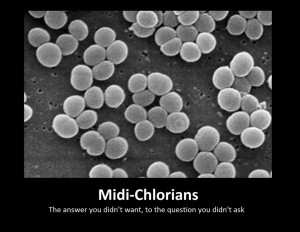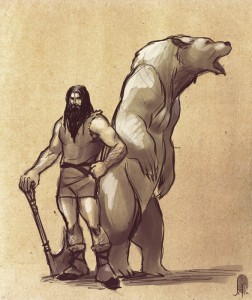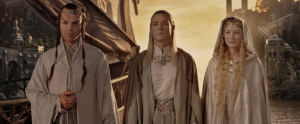
…The boy nodded his understanding. “Can I ask you something?” The Jedi Master nodded. “What are midi-chlorians?” Wind whipped at Qui-Gon’s long hair, blowing strands of it across his strong face. “Midi-chlorians are microscopic life-forms that reside within the cells of all living things and communicate with the Force.”…
…”Use the Force, Luke.”…
…Raistlin lifted his thin, frail hand and allowed the spell component he had taken from his pouch to fall slowly from between his fingers onto the deck of the boat. Sand, Tanis realized. “Ast tasarak sinuralan krynawi,” Raistlin murmured, and then moved his right hand slowly in an arc parallel to the shore….
…”The One Power,” Moiraine was saying, “comes from the True Source, the driving force of Creation, the force the Creator made to turn the Wheel of Time.”…
Bibbidi, bobbidi, boo.
There seem to be almost as many ways of representing magic as there are fantasy writers. Role-players know the whole system with mages, spell components, spellbooks, the language of magic, etc. Jordan fans can tell you the ins and outs of the One Power, complete with a discourse on the varying characteristics of saidar and saidin, and the innumerable levels of strength among Aes Sedai. And Star Wars geeks (a word I use with love, considering that I myself am a dyed-in-the-wool geek!) were stunned when Lucas started explaining the universe-balancing Force with microscopic middlemen, instead of with the innate power of Luke Skywalker and Darth Vader. What ties them in common is that they each have a system, a framework with rules and laws almost more complicated than those of physics. Mages lose their spells after one casting, and must rest and recommit the words to memory before casting again. Aes Sedai spend years in training, because abuse of the One Power can too easily lead to death… and evidently you’ve got to be well-stocked on single-celled symbionts (is that even a word? My spellchecker sure doesn’t like it) to even make a dent in the Force. Fantasy writers delight in coming up with their own, hopefully brand-new systems, to give their books that added twist, that spark that no other sword-swinging Elf-hopping kender-singing dragon-flying books have. But what about Tolkien? Where is the system? What are the rules which govern the making of Rings of Power, which delineate the powers and limits of Istari, of Maiar, of Valar? He never talks about a framework or physical laws; we only see the results of the power’s use. Where does the power come from?
![]()
“It’s wonderfully quiet here. Nothing seems to be going on, and nobody seems to want it to. If there’s any magic about, it’s right down deep, where I can’t lay my hands on it, in a manner of speaking.’
‘You can see and feel it everywhere,’ said Frodo.
‘Well,’ said Sam, ‘you can’t see nobody working it…I would dearly love to see some Elf-magic, Mr. Frodo!”
These passages between Sam and Frodo in Lórien are just about the only overt use of the word ‘magic’ in all of Lord of the Rings. Sam’s feeling, as it usually is for most of us, is that if ‘you can’t see nobody working it,’ then it must not be the real stuff. But I think Tolkien had another image in mind. He seems to have taken his love of nature and the natural order of things to such an extent that he would rather not impose an unnatural system of rules governing a supernatural power–what we term magic. Instead, it seems clear that Tolkien regarded extraordinary power as part of the natural birthright of individual beings, and as such, therefore, the exercise of that power was simply part of the settled order of events. Not magic, but just the use by each individual of the power vested in him or her–to the best and highest of his or her own abilities, be they the greatest of the great or the smallest of the small. And in fact, he regarded the traditional definitions of the word “magic” as tantamount to the evil Machine that tears up the normal fabric of nature.

Think about it. We at Green Books are constantly getting questions from readers so accustomed to other systems that they almost demand a system in Tolkien. “What were the exact powers of the One Ring?” “Does the magic in Lothlórien come from the Elves or vice-versa?” “What can Elrond do with his Elven-ring?” “How does Gandalf do magic?” We do the best we can to elucidate, but the plain truth of the matter is, Tolkien just doesn’t make rules. He expects us to accept at face value that Celebrimbor and his cohorts “forged” the Three Rings, that Fëanor “wrought” the Silmarils and contained within them the light of the stars of Varda, that Elrond, Gandalf, and Galadriel “use” their rings in some vague way for the protection and enhancement of their lands (in the cases of Elrond and Galadriel) and for the furtherance of their tasks (in the case of Gandalf). Even “What are the powers of Beorn? Why is he the only being in Middle-earth who can shape-change?” Well… because he just was. That was his individual power. Tolkien didn’t set out to create magicians who could manipulate a supernatural force. He created individuals who knew how to use their naturalpowers–and he delineated the difference between those who use their power for the sake of creation and those who use it merely for the sake of control.
Tolkien believed that human beings are endowed with creativity in order to share in God’s power of creation. He called this “sub-creation” and felt that he was making the most of his abilities in this line through his writing. It follows that the characters in his books would do the same. So everyone is endowed with his or her own abilities, and since he’s not limited to real human beings, but is free to imagine beings with greater powers of creation, the result is powers that to us are supernatural, but to him are merely the result of that being’s art. I am speaking, of course, of the wise and wonderful Elves. The forging of the Elven-rings is the best example, but their spellbound swords and beautiful works of cooperation with Dwarves also come to mind. A reader (thanks, Andróg!) sent me the exact quotation that details the nature of the Elves’ power, and, indeed, the difference between this power and “magic.” Letter 131 states: “Their ‘magic’ is Art, delivered from many of its human limitations; more effortless, more quick, more complete (product, and vision in unflawed correspondence). And its object is Art not Power, sub-creation not domination and tyrannous re-forming of Creation.” There you have it. Art for Art’s sake, and my favorite part–”product and vision in unflawed correspondence.” In other words, if they could think it (vision), then they could do it (product). No tiresome mechanics, no industrialized machines–just pure, unadulterated Art: sub-creation. Ultimately, what we would call magic is not, in Middle-earth, any such thing. It is simply the natural powers of created beings proceeding from them in yet another spiral of creation. And we know this power is inherent because Tolkien stated as much. The same Letter tells us: “By [the use of the word ‘magic’] I intend all use of external plans or devices (apparatus) instead of development of the inherent inner powers or talents–or even the use of these talents with the corrupted motive of domination; bulldozing the real world, or coercing other will.”
 So Tolkien divides power into two headings: The natural kind, proceeding from the desire of the being to sub-create, and ‘magic:’ a deliberate use of devices or machines with a corrupted motive. And in the use of the former, he stands alone in his system of creation. No other fantasy writer that I know has gone so far as he has with the Elves, given beings power that emanates as naturally as a flowing spring. True, there are other authors whose magic-users have innate talent, abilities, or senses not available to “ordinary” folks–but these special abilities are usually in existence in order to take advantage of an outside power: the Force, the One Power, or the generic, vague mysticism of “magic.” Tolkien’s Elves have no need of even the appearance of such supernatural forces, because the force of sub-creation is in them already, without any augmentation.
So Tolkien divides power into two headings: The natural kind, proceeding from the desire of the being to sub-create, and ‘magic:’ a deliberate use of devices or machines with a corrupted motive. And in the use of the former, he stands alone in his system of creation. No other fantasy writer that I know has gone so far as he has with the Elves, given beings power that emanates as naturally as a flowing spring. True, there are other authors whose magic-users have innate talent, abilities, or senses not available to “ordinary” folks–but these special abilities are usually in existence in order to take advantage of an outside power: the Force, the One Power, or the generic, vague mysticism of “magic.” Tolkien’s Elves have no need of even the appearance of such supernatural forces, because the force of sub-creation is in them already, without any augmentation.
A pet musing of mine is to wonder how this “sub-creation” applies to beings besides Elves, Valar, and Maiar. Don’t bombard me with letters about Gandalf’s magic words, either, because he was a Maiar, and a badass, to boot, and could do whatever he wanted, with words or without ‘em, in any language he pleased. I’m talking about mortals, now. Aragorn son of Arathorn. Faramir of Ithilien. Samwise Gamgee. I believe very deeply that this power of sub-creation extended very thoroughly to mortals of ‘uncorrupted motive,’ even if the results weren’t always what we would call ‘magical.’
“Now he is a marvel, the Lord Elfstone: not too soft in his speech, mind you, but he has a golden heart, as the saying is; and he has the healing hands. ‘The hands of the king are the hands of a healer,’ I said; and that was how it was all discovered. And Mithrandir, he said to me: ‘Ioreth, men will long remember your words,’ and…”
So spake Ioreth, wise woman of Gondor, and we know it to be true. Aragorn showed his healing powers many times, but never to greater effect than when he healed Faramir, Éowyn, and Merry of the Black Breath during the last days of the war.
“At last, less than a mile from the City, a more ordered mass of men came into view, marching not running, still holding together.
The watchers held their breath. ‘Faramir must be there,’ they said. ‘He can govern man and beast. He will make it yet.’”
![]() Our darling Faramir, a man of lore, yet scarcely less doughty in arms than his brother, and with a stern yet merciful attitude towards those under his command and in his power, had a gift for governance.
Our darling Faramir, a man of lore, yet scarcely less doughty in arms than his brother, and with a stern yet merciful attitude towards those under his command and in his power, had a gift for governance.
“Inside [the box] was filled with a grey dust, soft and fine, in the middle of which was a seed, like a small nut with a silver shale.
‘What can I do with this?’ said Sam.
‘Throw it into the air on a breezy day and let it do its work!’ said Pippin.
‘On what?’ said Sam.
‘Choose one spot as a nursery, and see what happens to the plants there,’ said Merry.
‘But I’m sure the Lady would not like me to keep it all for my own garden, now so many folks have suffered,’ said Sam.
‘Use all the wits and knowledge you have of your own, Sam,’ said Frodo, ‘and then use the gift to help your work and better it.’”
That last line sums up my entire feelings on the subject of mortals and sub-creation. Aragorn used athelas to help him in his healing, but undoubtedly part of the virtue of it sprang from his own hands. Faramir was versed in the lore and history of men, but he used his knowledge wisely and to good effect, being a good captain of his men and, in time, a steward and prince of his people. And our sweet Sam had a positive gift for growing things, no matter how much he was helped at that juncture by the gift of the Lady Galadriel.
Here’s the stickler: Just because the results aren’t conventionally ‘magical,’ doesn’t mean that a talent isn’t a gift of sub-creation. Any being, immortal or no, Elven or Human or Holbytla, who uses his or her inclinations and abilities to the fullest, and never forgetting that uncorrupted motive, is exercising his “inherent inner powers or talents”–a very personal form of magic that cannot be discounted. So many times in this dreary world we fall short of what we would like to accomplish with our abilities, through sloth or other impediments. Tolkien showed us not only otherworldly Elves whose gifts run to what we would consider outside the settled order of nature, but also very mortal characters who simply used their ordinary powers to the best and fullest extent. And the result, when compared with the many shortcomings and failings of human beings in this world, is very magical indeed.
– Anwyn


